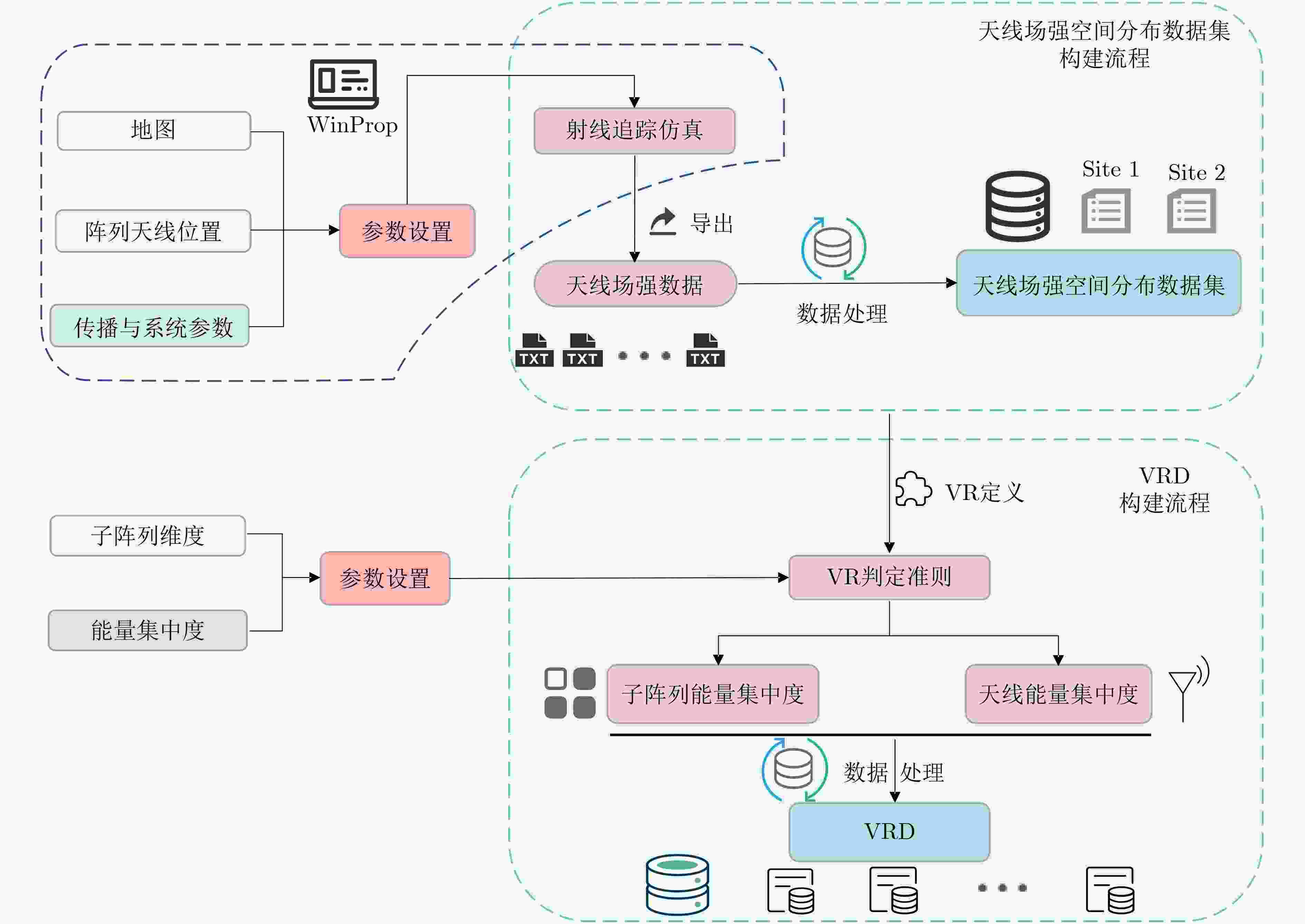Visibility Region Spatial Distribution Dataset for XL-MIMO Arrays
-
摘要: 可视区域(VR)信息可用于降低超大规模多输入多输出(XL-MIMO)系统传输设计复杂度,但现有理论分析与传输设计多基于简化的VR统计分布模型。为评估分析XL-MIMO在实际物理传播场景中的性能,该文公开了XL-MIMO阵列VR空间分布数据集,其由环境参数设置、射线追踪仿真、天线场强数据预处理和VR判定准则等步骤构建。该数据集针对典型城区无线传播场景,建立了用户位置采样与场强数据、VR数据之间的关联,总数据条目数量达上亿级。进一步对其中VR形态、VR分布进行了可视化展示与分析,并以基于VR的XL-MIMO用户接入协议为例,利用该数据集对其在真实传播场景中的性能进行了仿真,为该数据集的应用提供了典型样例。Abstract: The Visibility Region (VR) information can be used to reduce the complexity in transmission design of EXtremely Large-scale massive Multiple-Input Multiple-Output (XL-MIMO) systems. Existing theoretical analysis and transmission design are mostly based on simplified VR models. In order to evaluate and analyze the performance of XL-MIMO in realistic propagation scenarios, this paper discloses a VR spatial distribution dataset for XL-MIMO systems, which is constructed by steps including environmental parameter setting, ray tracing simulation, field strength data preprocessing and VR determination. For typical urban scenarios, the dataset establishes the connections between user locations, field strength data, and VR data, with a total number of hundreds of millions of data entries. Furthermore, the VR distribution is visualized and analyzed, and a VR-based XL-MIMO user access protocol is taken as an example usecase, with its performance being evaluated with the proposed VR dataset.
-
表 1 仿真参数设置
参数 参数设置 站点位置 场景内最高建筑物表面,site1: 150 m, site2: 50 m 天线类型及详细参数 每个站点200根天线(10×20),天线间距3 m,全向天线,频率 4800 MHz,发送功率1 W天线序号 site1: 011~210,site2: 20011 ~20210 场强空间分辨率 1 m 用户高度 高度统一为1.5 m 传播模型 智能射线追踪 1 天线能量集中度VR判定算法
输入:用户位置j天线场强数据$ {d_j}\left[ i \right] $,其中i表示天线标号;能量集中度P;初始化VR集合Sj为空;天线总数Nt 输出:用户j的VR集合Sj 1 计算用户j所在位置的场强和:${F^j} = \sum\nolimits_{i = 1}^{{N_{\mathrm{t}}}} {{d_j}\left[ i \right]} $; 2 用户j所能接收到的天线阵列上P (%)的能量,即阈值:${F^{j,P}} = {F^j} \times P$; 3 对数组$ {d_j}\left[ i \right] $按场强降序排序,生成新的2维数组${d'_j}\left[ {i,k} \right]$,其中i表示重新排序后的索引,k表示排序前天线的标号; 4 for (int t=0; t<=Nt; t++) 5 ${{\mathrm{sum}}} = {\text{sum}} + {d'_j}\left[ {i,k} \right]$; 6 天线k加入集合Sj; 7 if ${{\mathrm{sum}}} > {F^{j,P}}$ 8 Break; 9 返回VR Sj。 表 2 数据集汇总表
数据集类型 数据集名称 数据集含义 数据量 天线场强空间分布数据集 Antenna_site1 site1天线场强信息 60071000 Antenna_site2 site2天线场强信息 60071000 VRD 基于天线能量集中度的VRD S1_Antenna_user_80 site1下能量集中度80%的用户位置-天线VR构成信息 7702400 S2_Antenna_user_80 site2下能量集中度80%的用户位置-天线VR构成信息 3515400 S1_Antenna_VR site1峰值下天线VR分布 464 S2_Antenna_VR site2峰值下天线VR分布 279 基于子阵列能量集中度的VRD Antenna_subarray 天线-子阵列映射数据集 400 S1_user_sub_power_80 site1下能量集中度80%的用户位置-子阵列VR构成信息 547280 S2_user_sub_power_80 site2下能量集中度80%的用户位置-子阵列VR构成信息 725660 S1_Subarray_VR site1峰值下子阵列VR分布 27353 S2_Subarray_VR site2峰值下子阵列VR分布 36284 -
[1] LARSSON E G, EDFORS O, TUFVESSON F, et al. Massive MIMO for next generation wireless systems[J]. IEEE Communications Magazine, 2014, 52(2): 186–195. doi: 10.1109/MCOM.2014.6736761. [2] WANG Zhe, ZHANG Jiayi, DU Hongyang, et al. Extremely large-scale MIMO: Fundamentals, challenges, solutions, and future directions[J]. IEEE Wireless Communications. doi: 10.1109/MWC.132.2200443. [3] 张军, 陆佳程, 刘同顺, 等. 超大规模MIMO系统中基于交叠可视区域的功率分配方法[J]. 电子与信息学报, 2023, 45(12): 4262–4270. doi: 10.11999/JEIT221468.ZHANG Jun, LU Jiacheng, LIU Tongshun, et al. Power allocation method based on overlapping visibility region in extra large scale MIMO system[J]. Journal of Electronics & Information Technology, 2023, 45(12): 4262–4270. doi: 10.11999/JEIT221468. [4] CUI Mingyao and DAI Linglong. Channel estimation for extremely large-scale MIMO: Far-field or near-field?[J]. IEEE Transactions on Communications, 2022, 70(4): 2663–2677. doi: 10.1109/TCOMM.2022.3146400. [5] IIMORI H, TAKAHASHI T, ISHIBASHI K, et al. Joint activity and channel estimation for extra-large MIMO systems[J]. IEEE Transactions on Wireless Communications, 2022, 21(9): 7253–7270. doi: 10.1109/TWC.2022.3157271. [6] 丁瑞, 钱晓涵, 刘道华, 等. 超大规模MIMO信道测量建模研究综述[J]. 电讯技术, 2022, 62(7): 1014–1022. doi: 10.3969/j.issn.1001-893x.2022.07.028.DING Rui, QIAN Xiaohan, LIU Daohua, et al. Survey of channel measurement and modeling for extra-large scale massive MIMO[J]. Telecommunication Engineering, 2022, 62(7): 1014–1022. doi: 10.3969/j.issn.1001-893x.2022.07.028. [7] DE CARVALHO E, ALI A, AMIRI A, et al. Non-stationarities in extra-large-scale massive MIMO[J]. IEEE Wireless Communications, 2020, 27(4): 74–80. doi: 10.1109/MWC.001.1900157. [8] ZHANG Jingjing, ZHANG Jun, HAN Yu, et al. Average spectral efficiency for TDD-based non-stationary XL-MIMO with VR estimation[C]. The 14th International Conference on Wireless Communications and Signal Processing, Nanjing, China, 2022: 973–977. doi: 10.1109/WCSP55476.2022.10039284. [9] ALI A, DE CARVALHO E, and HEATH R W. Linear receivers in non-stationary massive MIMO channels with visibility regions[J]. IEEE Wireless Communications Letters, 2019, 8(3): 885–888. doi: 10.1109/LWC.2019.2898572. [10] MARINELLO FILHO J C, BRANTE G, SOUZA R D, et al. Exploring the non-overlapping visibility regions in XL-MIMO random access and scheduling[J]. IEEE Transactions on Wireless Communications, 2022, 21(8): 6597–6610. doi: 10.1109/TWC.2022.3151329. [11] RODRIGUES V C, AMIRI A, ABRÃO T, et al. Low-complexity distributed XL-MIMO for multiuser detection[C]. 2020 IEEE International Conference on Communications Workshops, Dublin, Ireland, 2020: 1–6. doi: 10.1109/ICCWorkshops49005.2020.9145378. [12] TIAN Jiachen, HAN Yu, JIN Shi, et al. Low-overhead localization and VR identification for subarray-based ELAA systems[J]. IEEE Wireless Communications Letters, 2023, 12(5): 784–788. doi: 10.1109/LWC.2023.3244000. [13] 杨小龙, 佘媛, 周牧, 等. 基于CSI的三维联合参数估计算法[J]. 电子与信息学报, 2022, 44(2): 627–636. doi: 10.11999/JEIT200698.YANG Xiaolong, SHE Yuan, ZHOU Mu, et al. 3D parameter estimation method based on CSI[J]. Journal of Electronics & Information Technology, 2022, 44(2): 627–636. doi: 10.11999/JEIT200698. [14] ALKHATEEB A. DeepMIMO: A generic deep learning dataset for millimeter wave and massive MIMO applications[EB/OL].https://doi.org/10.48550/arXiv.1902.06435, 2023. [15] ARNOLD M, HOYDIS J, and TEN BRINK S. Novel massive MIMO channel sounding data applied to deep learning-based indoor positioning[C]. The 12th International ITG Conference on Systems, Communications and Coding, Rostock, Germany, 2019: 1–6. doi: 10.30420/454862021. [16] DU Xu and SABHARWAL A. Massive MIMO channels with inter-user angle correlation: Open-access dataset, analysis and measurement-based validation[J]. IEEE Transactions on Vehicular Technology, 2022, 71(2): 1602–1616. doi: 10.1109/TVT.2021.3131606. [17] HAN Yu, TANG Wankai, JIN Shi, et al. Large intelligent surface-assisted wireless communication exploiting statistical CSI[J]. IEEE Transactions on Vehicular Technology, 2019, 68(8): 8238–8242. doi: 10.1109/TVT.2019.2923997. [18] TRINDADE I, MÜLLER F, and KLAUTAU A. Accuracy analysis of the geometrical approximation of MIMO channels using ray-tracing[C]. 2020 IEEE Latin-American Conference on Communications, Santo Domingo, Dominican Republic, 2020: 1–5. doi: 10.1109/LATINCOM50620.2020.9282262. [19] LIN Zhijian, DU Xiaojiang, CHEN H H, et al. Millimeter-wave propagation modeling and measurements for 5G mobile networks[J]. IEEE Wireless Communications, 2019, 26(1): 72–77. doi: 10.1109/MWC.2019.1800035. [20] SHIKHANTSOV S, GUEVARA A, THIELENS A, et al. Spatial correlation in indoor massive MIMO: Measurements and ray tracing[J]. IEEE Antennas and Wireless Propagation Letters, 2021, 20(6): 903–907. doi: 10.1109/LAWP.2021.3066607. [21] HARON A S, MANSOR Z, AHMAD I, et al. The performance of 2.4GHz and 5GHz Wi-Fi router placement for signal strength optimization using Altair WinProp[C]. The IEEE 7th International Conference on Smart Instrumentation, Measurement and Applications, Bandung, Indonesia, 2021: 25–29. doi: 10.1109/ICSIMA50015.2021.9526299. [22] DE SOUZA J H I, AMIRI A, ABRÃO T, et al. Quasi-distributed antenna selection for spectral efficiency maximization in subarray switching XL-MIMO systems[J]. IEEE Transactions on Vehicular Technology, 2021, 70(7): 6713–6725. doi: 10.1109/TVT.2021.3081462. [23] LIU Daohua, WANG Jue, LI Ye, et al. Location-based visible region recognition in extra-large massive MIMO systems[J]. IEEE Transactions on Vehicular Technology, 2023, 72(6): 8186–8191. doi: 10.1109/TVT.2023.3242615. -






 下载:
下载:









 下载:
下载:
